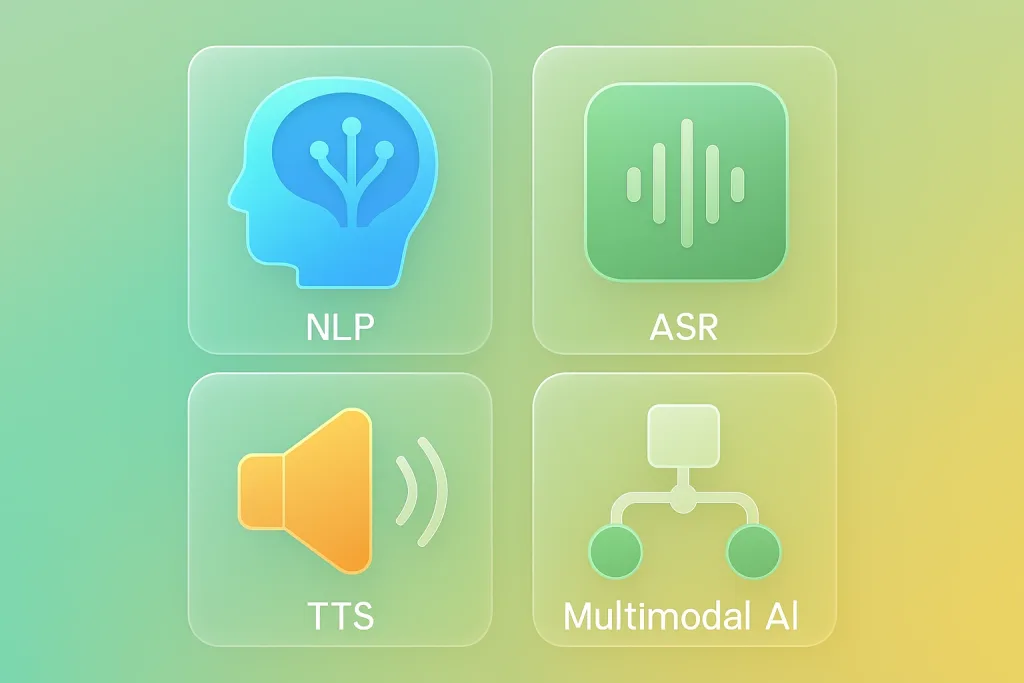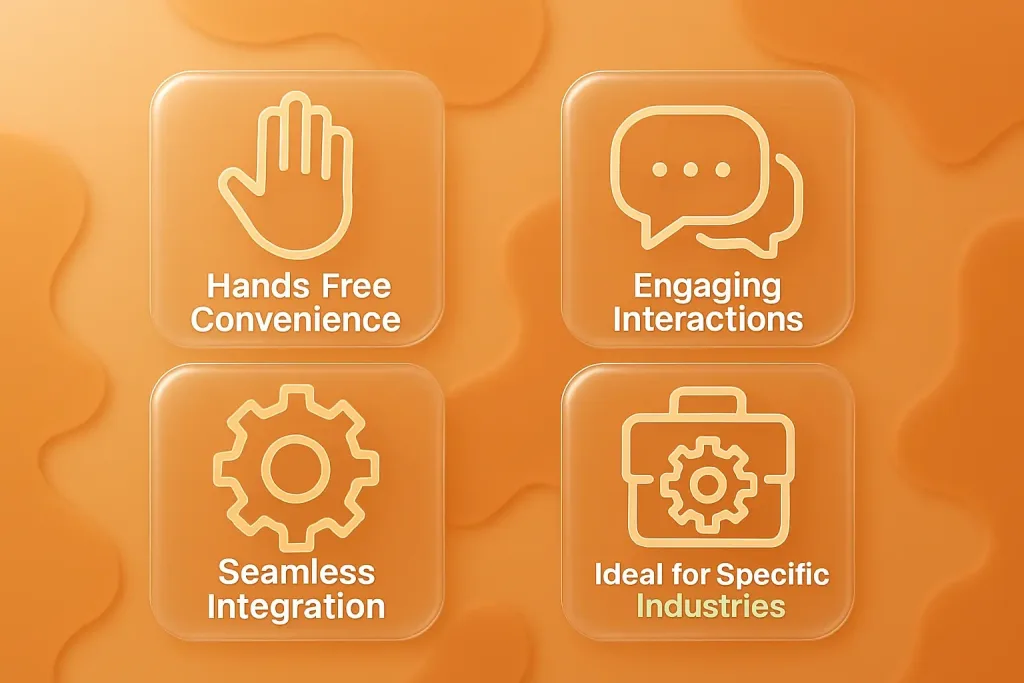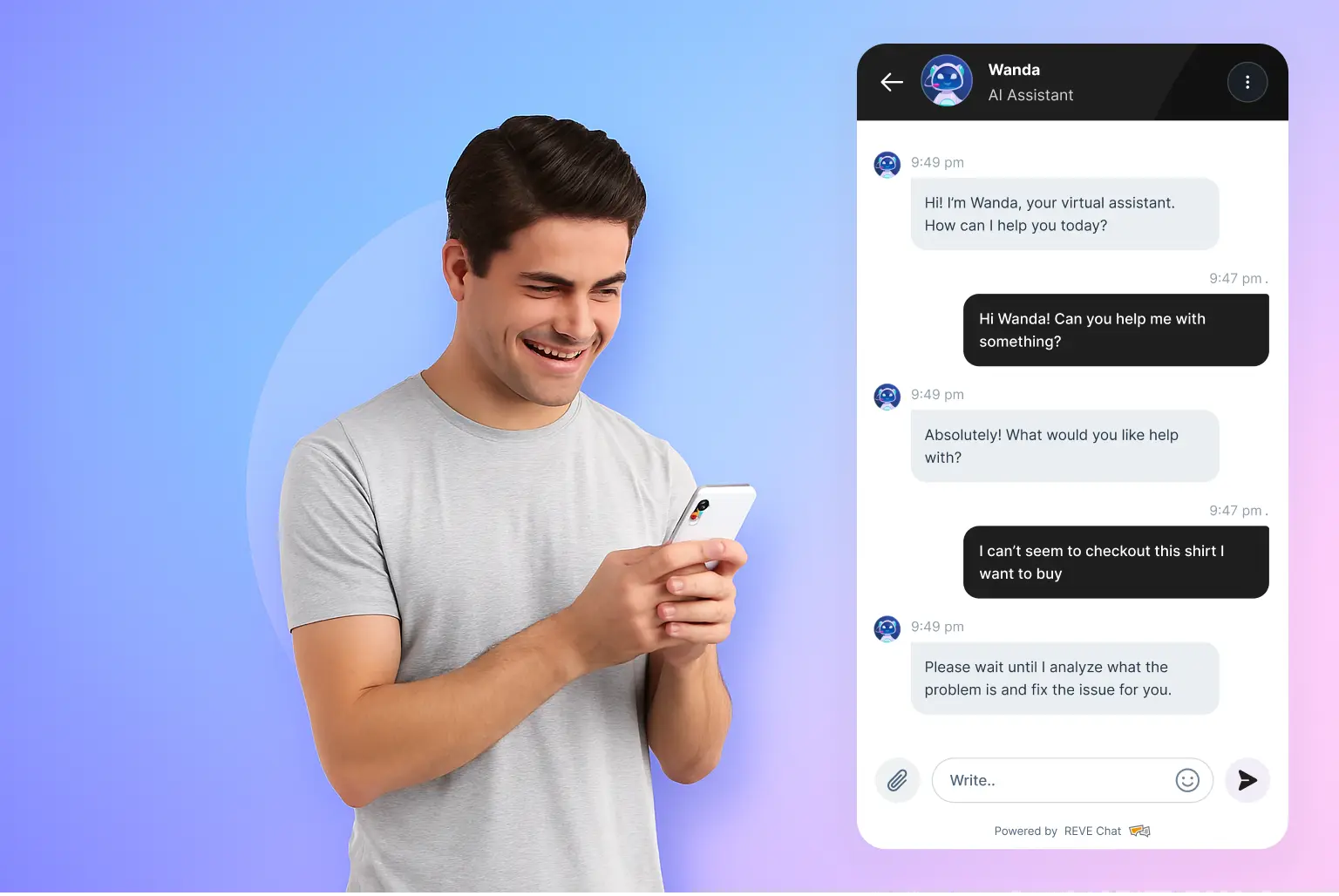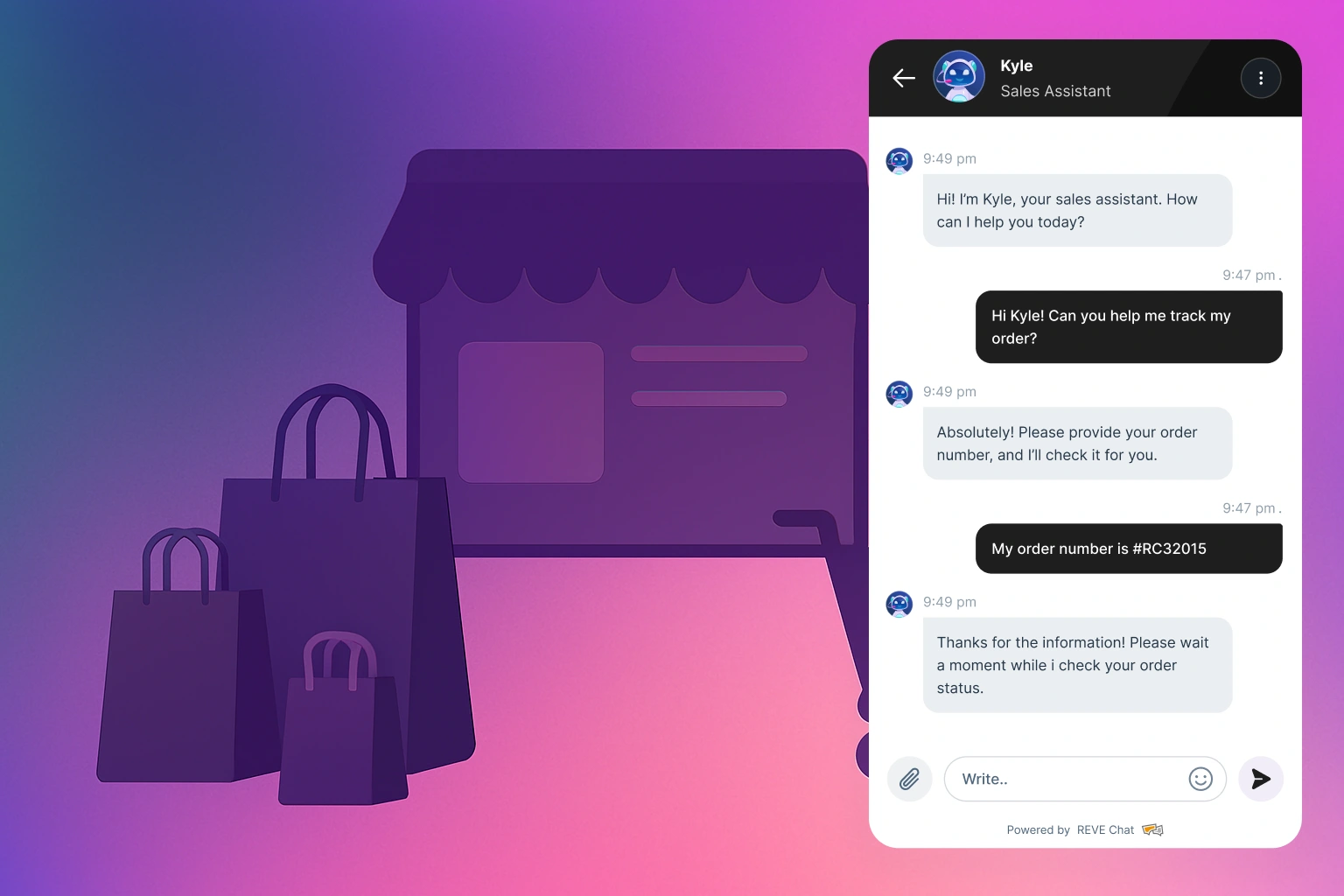Chatbot Vs. Voicebot in 2025: Your Guide to Choosing the Right AI
- July 24, 2025
- 19 mins read
- Listen

Conversational AI is transforming business. By 2026, 80% of customer interactions will rely on it, saving costs and boosting satisfaction. Just think of a situation where a chatbot suggests shoes on an online store or a voicebot takes your pizza order hands-free while you drive.
Both deliver seamless experiences, yet they use different tech. Choosing between a chatbot’s text-based ease and a voicebot’s hands-free convenience can be tricky.
Each excels in unique ways. This guide dives into their differences, strengths, and real-world uses to help you pick the perfect AI for your business.
Let’s get started.
What Are Chatbots and Voicebots? Definitions and Core Concepts
Chatbots and voicebots are the stars of conversational AI, each with unique strengths. Let’s break them down.
What’s a Chatbot?
A chatbot is an application that converses with you through text. Think of it as a virtual assistant living in your favorite apps or websites. It answers questions, guides purchases, or solves issues fast.
For example, when you ask a retail site about shipping, a chatbot replies instantly with details. They use natural language processing (NLP) to understand and respond naturally.
They can be on websites, apps, and platforms like WhatsApp or Facebook Messenger. Plus, they work 24/7, unlike human agents. Businesses love them for quick, cost-effective support.
Learn More: What is a Chatbot and How Does it Work
What’s a Voicebot?
A voicebot, or voice assistant, interacts through speech. It’s like talking to a friend who’s really good at multitasking. Say “book a table for two” to your phone, and a voicebot like Siri or Alexa handles it in seconds. No typing needed.
Voicebots rely on advanced tech: automatic speech recognition (ASR) to turn your words into text, NLP to understand them, and text-to-speech (TTS) to reply with a human-like voice.
For instance, a restaurant voicebot hears your order, processes it, and confirms it aloud, all in moments.
They’re perfect for hands-free tasks, from setting reminders to controlling smart home devices.
Common Ground Between Chatbot and Voicebot
Both chatbots and voicebots use NLP to “get” what you’re saying. This AI tech lets them analyze your words, spot intent, and respond helpfully.
However, voicebots take it further with ASR and TTS for audio magic.
While chatbots shine in text-based platforms, voicebots excel in voice-driven settings like smart speakers or phone systems.
Prominent Technologies Behind Chatbots and Voicebots

Ever wondered how a chatbot instantly answers your question on a website or a voicebot books your hotel room just by hearing your voice?
It’s not magic, it’s cutting-edge tech.
Chatbots and voicebots rely on powerful AI tools to understand you and respond like a human.
Let’s dive into the tech driving these conversational stars and see what makes them tick.
1. NLP: The Brain of Both Bots
Both chatbots and voicebots depend on natural language processing, or NLP.
It’s the tech that lets machines understand human language. Think of NLP as a super-smart librarian who quickly finds meaning in your words.
It analyzes what you say or type, spots your intent, and crafts a helpful reply.
NLP breaks your input into smaller pieces, like words or phrases. Then, it compares them to a massive dataset it’s trained on.
For example, if you type “track my order” to a chatbot, NLP figures out you want shipping details.
You know what, NLP has grown smarter with generative AI, like models behind ChatGPT or Google’s Gemini.
These let bots handle complex questions, understand context, and even pick up on sarcasm. Pretty cool, right?
A subset of NLP, called natural language understanding (NLU), takes it further. NLU helps bots grasp nuances, like whether “I’m freezing” means you’re cold or frustrated.
This makes conversations feel natural, whether you’re texting a chatbot or talking to a voicebot.
2. Automatic Speech Recognition (ASR): Voicebots’ Ears
Voicebots have an extra trick: automatic speech recognition, or ASR. This tech turns your spoken words into text.
For example, you say, “Order a pizza with extra cheese.” ASR listens, converts your speech to text, and sends it to NLP for processing.
It’s like a translator for your voice.
ASR isn’t simple. It has to handle accents, background noise, and fast talkers.
These days, ASR is better than ever with deep learning. For instance, a voicebot in a noisy café can still understand your order.
But challenges remain.
Thick accents or slang can trip it up, and training ASR needs tons of voice data. Still, it’s why voicebots like Alexa feel so responsive.
3. Text-to-Speech (TTS): Voicebots’ Voice
Once a voicebot understands you, it needs to reply. That’s where text-to-speech (TTS) comes in. TTS turns text responses into spoken words. It’s what gives Siri or Google Assistant their human-like voices.
For example, after processing your pizza order, the voicebot uses TTS to say, “Got it, your pizza’s on the way.”
TTS is incredibly lifelike now. New algorithms mimic natural tone, pitch, and even emotion. Some voicebots can sound excited or calm based on your request.
However, TTS isn’t perfect. It can struggle with unusual names or technical terms. Plus, creating expressive voices requires hefty computing power.
4. Multimodal AI: The Next Frontier
Chatbots and voicebots are blending into multimodal AI. This tech combines text, voice, and visuals for richer interactions.
For instance, Google’s Search Live or xAI’s Grok can analyze a photo you upload, answer questions about it, and respond via text or voice.
For example, you’re asking a bot, “What’s this dish?” while sharing a picture, and getting a recipe in return.
Multimodal AI is pushing boundaries, making bots more versatile.
Chatbot vs. Voicebot: Key Differences
Both are smart, but they’re not twins. They work differently, serve unique purposes, and fit specific business needs.
| Feature | Chatbot | Voicebot |
| Communication | Text-based | Speech-based |
| Backend Tech | AI, NLP, Machine Learning | ASR, TTS, NLP, Language Detection |
| Development | Easy, no-code platforms | More complex, requires voice tech |
| Cost | Cost-effective | Higher cost |
| Devices | Any device with a screen | Needs mic/speaker |
| Visuals | Supports images, videos, GIFs | Audio-only |
| Integrations | Websites, apps, messaging platforms | Phone systems, smart speakers, CRMs |
Let’s break down the key differences between chatbots and voicebots to help you decide which one’s your best bet.
1. How They Communicate
Chatbots talk through text. You type a question, they type back. It’s like texting a super-fast friend who’s always online. For example, a chatbot on an eCommerce site might reply, “Your order ships in 2 days!” with a tracking link.
Voicebots, on the other hand, use speech. You say, “Book a table for four,” and they respond aloud, “Got it, table reserved for 7 PM.”
They’re perfect for hands-free moments, like driving or cooking. This core difference, text versus speech, shapes how each bot fits into your business.
2. Tech Behind the Scenes
Chatbots rely on artificial intelligence (AI) and natural language processing (NLP). These let them understand and respond to typed messages.
Some also use machine learning to get smarter over time. It’s straightforward but powerful.
Voicebots need more tech. They use NLP too, but add automatic speech recognition (ASR) to turn your voice into text and text-to-speech (TTS) to speak back.
They might also include language detection for multilingual users.
For instance, a voicebot in a call center hears your request, processes it, and replies, all in seconds.
This extra tech makes voicebots more complex but ideal for voice-driven tasks.
3. Building and Managing Them
Creating a chatbot is often easier. With platforms like REVE Chat, you can build one using drag-and-drop tools.
No coding needed. You set up responses, test, and launch quickly. Updates are simple, too, just tweak the text. Get a free trial now.
Voicebots are trickier. They need ASR and TTS systems, which require more setup. Training them to understand accents or handle noisy environments takes effort.
However, modern tools in 2025 make voicebot development smoother, even for teams with basic tech skills.
Still, expect a bit more work than with chatbots.
4. Cost Comparison
Chatbots are budget-friendly. They don’t need special hardware, just a website or app to live on. Development and maintenance costs are low, especially with no-code platforms.
For small businesses, this is a big win. Book a demo to see how REVE Chat can help you boost your business.
Voicebots cost more.
They require high-quality microphones, speakers, or phone systems. Plus, advanced ASR and TTS tech isn’t cheap.
Maintenance, like updating voice models, adds to the bill. For example, a restaurant might spend more on a voicebot for phone orders than on a chatbot for online FAQs.
5. Device Requirements
Chatbots work on any device with a screen, phones, laptops, and tablets. You can chat on a website, app, or platforms like WhatsApp.
They’re everywhere, no extra gear needed.
Voicebots need devices with mics and speakers. Think phones, smart speakers, or in-car systems.
For instance, Alexa needs a smart speaker to shine. This limits voicebots to specific setups but makes them great for hands-free use.
6. Visual Capabilities
Chatbots can show off visuals. They send images, videos, or GIFs to make chats fun.
For example, a fashion store chatbot shares a video of a new dress. This adds flair and helps explain complex ideas, like product features.
Voicebots stick to audio. They can’t share visuals, which limits their style. However, their voice responses feel personal, using tone or sound effects.
A voicebot might say, “Your pizza’s baking!” with a cheerful tone, but it won’t show you the pizza.
7. Integration Options
Chatbots integrate easily with websites, mobile apps, and messaging platforms like Facebook Messenger or Telegram. They’re flexible, fitting into your existing digital setup. For example, REVE Chatbot syncs with your CRM to track customer chats.
Voicebots integrate with voice systems, like phone lines or smart speakers. They can connect to CRMs too, but shine in call centers or smart home devices.
A voicebot might let customers book appointments via Alexa, creating a seamless experience. However, integration can be complex compared to chatbots.
Advantages of Chatbots: Why They Shine

Just think of a customer stuck on your online store. A chatbot pops up, answers their question, and suggests a product in seconds.
Chatbots are fast, versatile, and budget-friendly. Here’s why they stand out.
1. Visual-Rich User Experience
Chatbots make chats engaging with images, videos, or GIFs.
A fashion store’s bot might show a jacket’s photo. They also personalize replies using past chats, like suggesting shoes based on browsing history.
Unlike voicebots’ audio-only approach, chatbots offer a visual, interactive experience.
2. Easy to Build
Building chatbots is simple with tools like REVE Chat’s drag-and-drop platform. No coding needed. Add FAQs or update responses quickly. Here is a tutorial to build a simple chatbot.
Compared to voicebots’ complex speech systems, chatbots are faster to launch and refine, saving time for busy teams.
3. Cost-Effective
Chatbots save money. They run on websites or apps, needing no special hardware. No-code platforms keep development costs low.
Maintenance is easy, just update the text. Voicebots, with their pricey speech tech, cost more, making chatbots ideal for startups.
4. Global Language Support
Chatbots handle multiple languages easily, with no accent issues. A travel agency’s bot can assist in Spanish or English seamlessly.
This makes them perfect for diverse, global audiences, unlike voicebots, which struggle with varied speech patterns.
5. Versatile Use Cases
Chatbots excel in eCommerce, answering FAQs or upselling products.
They handle customer support queries or collect leads via forms. You can integrate it with WhatsApp, apps, social media, email, websites, and more.
It automates signups to post-sale support across industries.
Advantages of Voicebots: Why They Stand Out

Just think of a situation where you’re ordering coffee while driving, just by telling your car’s voicebot what you want.
It’s fast, hands-free, and feels like chatting with a friend. Voicebots are stealing the show for their unique strengths.
They’re perfect for seamless, human-like interactions.
Here’s why voicebots shine.
1. Hands-Free Convenience
Voicebots let you talk, not type. Say “book a hotel” while cooking, and it’s done. They’re ideal for multitasking or for users with disabilities who need hands-free options.
For example, a driver can use a voicebot to call customer support without touching their phone.
Unlike chatbots, which require screens, voicebots work anywhere with a mic.
2. Engaging, Personal Interactions
Voicebots sound human. They use tone, pitch, and even humor to make chats lively. A restaurant voicebot might say, “Your table’s ready!” with a cheerful vibe.
Advanced text-to-speech tech makes them even more natural. This personal touch boosts customer engagement, unlike chatbots’ text-only replies.
3. Seamless System Integration
Voicebots connect easily with phone systems, smart speakers, or CRMs.
For instance, a voicebot linked to Alexa can schedule appointments from home. They also work with call centers, handling high call volumes.
While chatbots integrate with apps, voicebots excel in voice-driven setups, offering flexibility for modern businesses.
4. Ideal for Specific Industries
Voicebots thrive in hands-free settings. In healthcare, they schedule appointments via phone. In hospitality, they take reservations.
A car’s voicebot can adjust settings while you drive. These use cases make voicebots a top choice for industries needing quick, voice-based solutions, unlike chatbots’ text focus.
Chatbot Vs. Voicebot: Limitations and Major Challenges
Chatbots and voicebots aren’t flawless. Each has unique limitations and challenges. A chatbot might misread your query sometimes, or a voicebot could stumble on your accent.
These hurdles can affect your business. Knowing their limits helps you plan better. Let’s explore the challenges and how to fix them.
Chatbot Limitations
Chatbots can feel stiff. Complex questions like “Why’s my order late?” may get vague replies if training is weak.
They need screens, so hands-free users, like drivers, are out of luck. Plus, text-based chats miss emotional cues, limiting empathy.
Voicebot Limitations
Voicebots struggle with speech. Accents or noisy settings, like a busy café, can confuse them. They’re costly, needing pricey tech like microphones.
Integration with CRMs or phone systems is also tougher than chatbots’ simple app setups.
Common Challenges
Both bots face privacy risks. They handle user data, so GDPR compliance is key. Training needs big datasets, as poor data means poor answers.
Some customers resist bots, preferring humans for issues like billing disputes.
Industry-Specific Chatbot and Voicebot Applications
Chatbots and voicebots aren’t one-size-fits-all. They shine in different ways depending on your industry. Whether you run an online store or a hospital, these AI tools can transform how you serve customers.
Picking the right bot means matching it to your business needs.
Let’s explore how chatbots and voicebots excel in eCommerce, healthcare, hospitality, finance, and telecom, with real-world examples to guide you.
1. eCommerce: Shopping Made Smarter
Chatbots are amazing customer service tools for eCommerce. They guide customers through product searches, suggest items, and answer questions fast.
For example, a shopper asks, “Find me a red dress under $50,” and a chatbot like REVE Chatbot instantly shows options with images. They also upsell, recommending accessories based on past purchases.
Voicebots, meanwhile, enable hands-free ordering. For example, a busy parent saying, “Order diapers,” to a voicebot via a smart speaker.
It confirms the order in seconds. While chatbots excel at visual recommendations, voicebots make shopping effortless for multitasking customers.
Healthcare: Streamlining Patient Care
Voicebots are bringing a revolution in healthcare. They handle appointment scheduling over the phone, freeing up staff. A patient might say, “Book me for next Tuesday,” and the voicebot sets it up, even checking insurance details. They’re also great for patient triage, asking about symptoms to prioritize urgent cases.
Chatbots shine in patient portals. They answer FAQs like “What’s my test result?” or guide users through online forms.
For instance, a hospital’s chatbot can explain medication instructions with links to videos. Voicebots suit urgent, hands-free tasks, while chatbots handle detailed, text-based support.
2. Hospitality: Enhancing Guest Experiences
Voicebots make hospitality feel personal. Guests can call a hotel and use a voicebot to book rooms or request concierge services.
Saying “Reserve a table for dinner” gets an instant reply, “Table for two at 7 PM.” Voicebots integrate with smart room devices, letting guests control lights or AC by voice.
Chatbots, on the other hand, confirm bookings online. They send text reminders or share hotel policies with visuals. A guest might ask, “What’s the check-in time?” and get a quick answer with a map.
Voicebots offer hands-free convenience, while chatbots provide detailed, visual confirmations.
3. Finance: Secure and Efficient Service
Chatbots are finance favorites for quick account inquiries. A customer types, “Check my balance,” and the chatbot responds with details, often showing a transaction graph.
They’re also great for fraud detection, flagging odd activity, and asking for confirmation via text. This speed saves time and builds trust.
Voicebots excel in secure authentication. For instance, a customer calling to verify their identity. The voicebot uses voice recognition to confirm it’s them, reducing fraud risks. In addition, voicebots handle sensitive tasks like password resets over the phone, while chatbots manage routine queries with visuals.
4. Telecom: Simplifying Customer Support
Chatbots tackle common issues fast. Customers ask, “Why’s my internet slow?” and the chatbot diagnoses it, suggesting a router reset with a video guide.
They also handle billing queries or plan upgrades, integrating with apps like WhatsApp for seamless chats.
Voicebots shine in call centers. A customer calls about a service outage, and the voicebot explains, “We’re fixing it by 3 PM,” using real-time data.
They reduce wait times by handling high call volumes. Chatbots offer visual support, while voicebots manage urgent, voice-based queries.
How to Choose: A Decision-Making Framework
Choosing between a chatbot and a voicebot is like picking coffee or tea. It depends on your needs. AI drives 80% of customer interactions, so the right bot boosts your business.
This framework guides you through industry, audience, budget, and more.
Let’s dive in.
Step 1: Match Your Industry
Industries favor different bots. Chatbots excel in eCommerce, showing product photos fast. Hospitality leans toward voicebots for phone reservations.
Healthcare uses voicebots for triage, and finance prefers chatbots for account checks.
Ask: Does my industry need visuals or hands-free tasks?
Step 2: Know Your Audience
Your customers’ preferences matter. Young users like voicebots for quick tasks, like ordering via Alexa. Text-savvy or older audiences prefer chatbots for detailed queries, like warranties.
Consider: Do my customers type or talk? Chatbots suit global, multilingual users; voicebots fit local, voice-driven ones.
Step 3: Check Your Budget
Chatbots are affordable, needing just a website or app. Voicebots require pricey speech tech and microphones. A startup might pick a chatbot, while a hotel can afford a voicebot.
Ask: Can I invest in voice tech, or need a budget option?
Step 4: Evaluate Task Complexity
Chatbots handle tasks like FAQs, tracking orders, fraud detection, and more. Voicebots suit complex, hands-free tasks, like booking appointments while driving.
A telecom might use both chatbots for billing and voicebots for calls.
Consider: Are my tasks routine or voice-based?
Step 5: Assess Integration
Chatbots sync easily with apps or WhatsApp, and CRMs. Voicebots connect to phone systems or smart speakers, but need more setup.
A retailer might choose a chatbot for apps, a call center, and a voicebot.
Ask: Do my systems support text or voice better?
Future of Chatbots and Voicebots in 2025
What’s next for chatbots and voicebots? Conversational AI is evolving fast, blending cutting-edge tech with real business value. It comes from hybrid bots to smarter interactions, the future looks bright.
Here’s how chatbots and voicebots will shape customer experiences.
Multimodal AI Takes Center Stage
Chatbots and voicebots are merging into multimodal AI. These bots handle text, voice, and visuals at once.
For example, a customer uploads a shoe photo to a retail bot and asks, “Find this style.” The bot replies via text or voice, showing similar products.
Tools like xAI’s Grok or Google’s Search Live lead this trend, making interactions richer. Businesses benefit from seamless, all-in-one customer support.
Generative AI Boosts Smarts
Generative AI, like advanced models behind ChatGPT or Gemini, makes bots smarter. They understand context better, handling complex queries like “Plan my trip budget.”
Chatbots craft detailed text responses, while voicebots sound more human with expressive tones.
This means fewer misunderstandings and happier customers. Especially for small businesses, automating support.
Hybrid Bots for Flexibility
Hybrid bots combine chatbots and voicebots. A hotel might use a hybrid bot to answer text queries online and take voice bookings by phone. This flexibility cuts costs and boosts efficiency across industries.
Wider Adoption in Small Businesses
Affordable no-code platforms make chatbots accessible for startups, handling tasks like lead capture.
Voicebots, now cheaper with cloud-based speech tech, suit small cafes or clinics for phone orders. By 2026, 80% of customer interactions will use AI, leveling the playing field for smaller players.
Real-Time Data Integration
Bots are getting savvier with real-time data. Chatbots pull live inventory for eCommerce, while voicebots check flight statuses via phone. APIs link bots to web searches or internal systems, delivering instant answers.
This speed drives customer loyalty and streamlines operations.
Conclusion
Chatbots and voicebots are reshaping how you connect with customers. Chatbots shine with visual, text-based support, perfect for eCommerce or FAQs.
Voicebots excel in hands-free tasks, like booking reservations on the go. Each has unique strengths, from cost-effective chatbot platforms to voicebots’ engaging speech. Yet, both face challenges, like privacy or training needs.
The key? Match the bot to your industry, audience, and budget.
AI powers 80% of customer interactions, saving time and boosting loyalty. Whether you need a chatbot’s visuals or a voicebot’s convenience, the right choice drives results.
Ready to transform your customer experience? Sign up for REVE Chat’s 14-day free trial today and see how it can streamline your support, from websites to WhatsApp.
Frequently Asked Questions
Chatbots use text for chats, ideal for websites or apps. Voicebots rely on speech, perfect for hands-free tasks like phone bookings.
Chatbots suit small businesses with lower costs and easy setup. They handle FAQs or leads well. Voicebots fit bigger budgets.
Yes, but with limits. In 2025, advanced NLP helps both, though chatbots excel with text details, and voicebots may mishear accents.
Chatbots are affordable, using software like REVE Chat. Voicebots cost more, needing speech tech and hardware like microphones.
Absolutely, 2025 hybrid bots combine both. A retailer might use a chatbot for app chats and a voicebot for phone orders.




